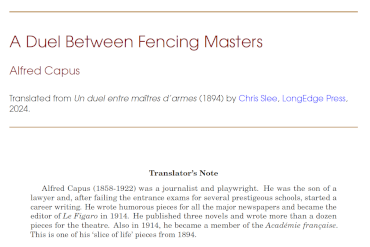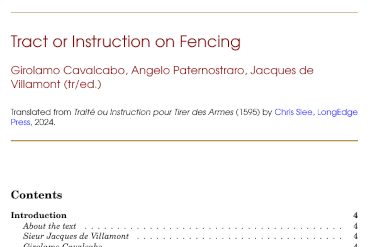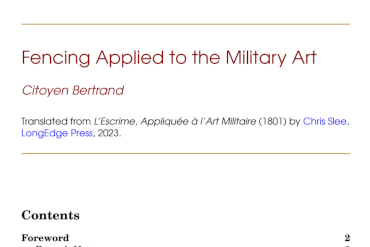PDF Catalog
- All Periods
- Renaissance Period
- Nineteenth Century
- Other

A Duel Between Fencing Masters
Download PDF Now
This translation of Alfred Capus' A Duel Between Fencing Masters presents a humorous "slice of life" showing the copntemporary debate between "practical" and "conventional" fencing.

Tract or Instruction on Fencing
Download PDF Now
This translation of Cavalcabo and Patenoster was a popular sensation in period France. From this, Cavalcabo and his son gained employment as fencing masters at the court of King Henry IV of France.

Manual of Contre-Point Fencing
Download PDF Now
Joseph Tinguely wrote his Manual of Contre Pointe Fencing when the sabre, a thug's weapon, was being introduced into the academic discipline of fencing. Foreword by Julien Garry of De Taille et d’Estoc.

André des Bordes: History of Sorcerers in the Lorraine
Download PDF Now
Episode from the History of Sorcerors tells of the rise and downfall of André des Bordes, French fencing master under the dukes of Lorraine, and his trial on charges of witchcraft.

The Phantom Cavalier who Fought a Duel
Download PDF Now
Found in a famous collection of 19th century folklore, The Phantom Cavalier who Fought a Duel is one of the more bizarre examples of 17th century tracts against dueling.

Fencing Through the Ages -- The Cycle of the Sword
Download PDF Now
The script of George Eekhoud's public performance in Brussel, 1894, at which Alfred Hutton and the London Rifle Brigade was invited to perform.

Le Combat de Seul à Seul en Camp Clos
Download PDF Now
A transcription Marc de la Beraudiere's Le Combat de Seul à Seul en Camp Clos 1608 which lists who can and cannot undertake a duel and the rules by which they must abide. (French)

L'Escrime, Appliquée à l'Art Militaire
Download PDF Now
One of the few surviving texts about fencing from during the time of the Napoleon, L'Escrime, Appliquée à l'Art Militaire is a unique snapshot of the history of fencing in France. (French)

Fencing Applied to the Military Art
Download PDF Now
The text describes basic fencing before showing how it should be applied to training platoons and companies of soldiers. Very few sources show the military use of fencing skills.

Science of Arms: Sabre Exercises
Download PDF Now
The Science of Arms in the Cavalry: Sabre Exercises is one of a number of pamphlets on cavalry life written by ex-army fencing master Romuald Brunet.
